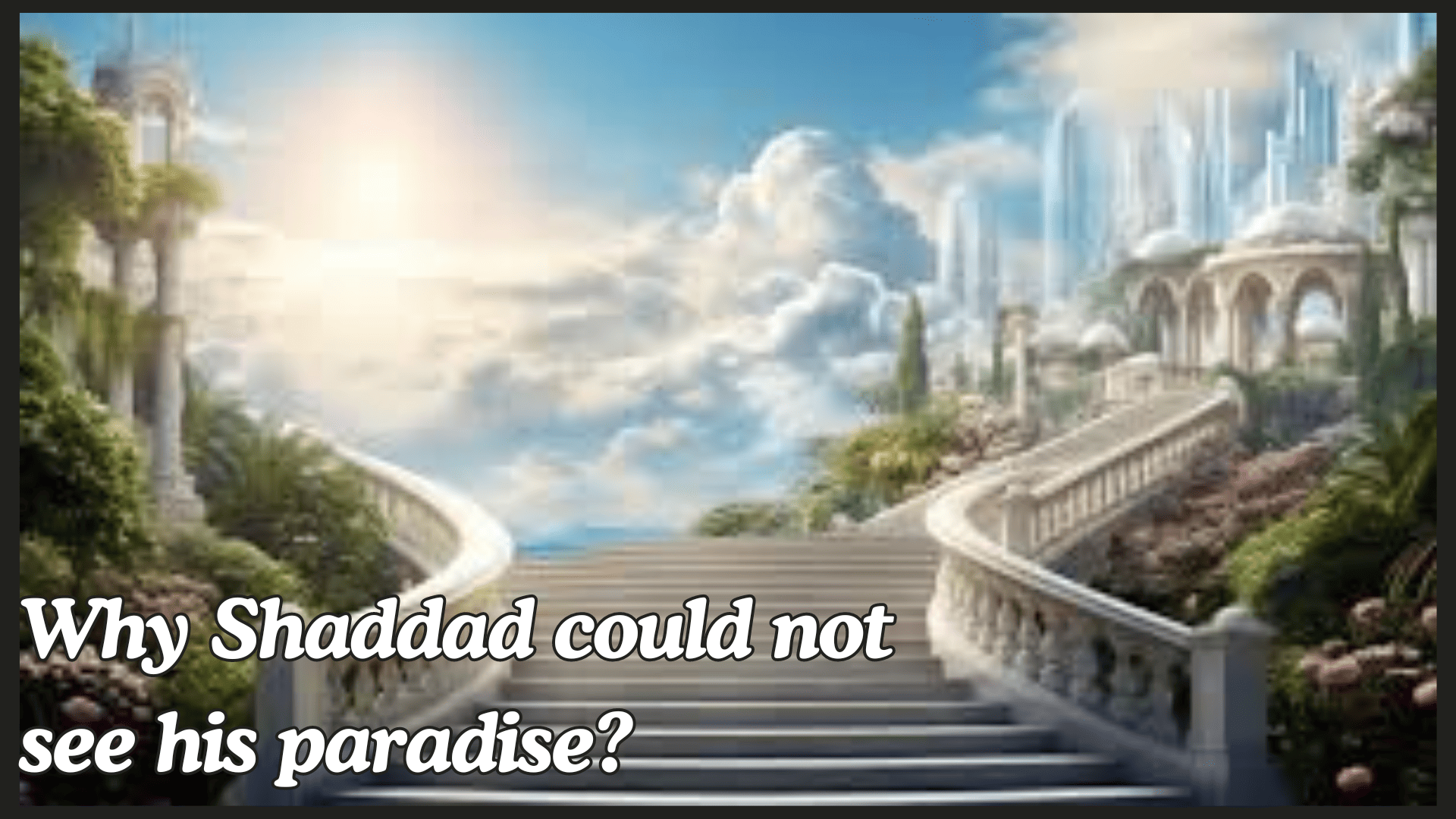Welcome to (International Stories). In this story, we will discuss Why Shaddad could not see his paradise? I hope you will like this story and understand it.

Why Shaddad could not see his paradise?
Let us tell you something interesting and strange about Shadad’s paradise today.
A precious one from the shining chapter of the history of Islam.
True story
Nation of Aram:
These people belonged to the nation of Aad and they were residents of the settlement named Iram. That settlement had big pillars. Imad is plural of Imad and Imad means pillar. Two nations have passed by the name of Aad. One is called “Aad-e-Qitima or “Aad-e-Iram.”
He was one of the descendants of Aad bin Awad bin Iram bin Sam bin Nuh. He is also called Aad-e-Iram after his grandfather. He also named his city after his grandfather. His homeland was adjacent to Aden.
Hazrat Hud (a.s.) was sent to them, but when they were destroyed due to the misdeeds of the people of ‘Ad, Hazrat Hud (a.s.) returned to the presence of death. His residence was in Ahqaf area.
Hazrat Hud died here. This nation living in Ahqaf developed a lot. Allah Ta’ala had given this nation extraordinary strength and power. Each of them was at least twelve yards tall. Such was the state of power that the biggest stone which many men could not lift together, one of them
He used to pick it up with one hand and throw it away. These people occupied the whole of Yemen by force. Two kings in particular became very famous among them. They were both brothers. The name of one was Khatib who was big. The name of the other was Shaddad who succeeded him. Both of them occupied a vast area and accumulated countless armies and treasures.
The story of Aadiram Shaddad
The story of Aadiram Shaddad brought the splendor of the kingdom to its peak after his brother Khattab. Many kings of the world were his tributaries. In that era, no king had the courage and strength to face him. This domination and dominance made him so proud and arrogant that he claimed to be God.
The scholars and reformers of that time, who were the inheritors of the knowledge of the previous prophets, explained to him and threatened him with the punishment of Allah, so he said, the government, wealth and honor that he has now, is more than worshiping Allah.
What will be achieved? Whoever serves and obeys someone, either for the advancement of honor and position or for the sake of wealth, I have all this, why do I need to worship anyone?
Hazrat Hud also tried to explain him but in vain.
The explainers also said that this government and wealth is a mortal thing, while obedience to Allah leads to ultimate salvation and attaining Paradise, which is better and more valuable than all the wealth of the world. He asked, what is this heaven like?
Explain its merits and demerits. Those who gave advice explained to him the attributes of heaven that were known to him through the teachings of the Prophets, so he said, “I don’t need this heaven, I can create such a heaven myself in this world.”
Paradise of Shaddad
So he called one hundred reliable people from among his officers. Appointed each one to a thousand men and explained to all of them his point of view and choice in connection with the construction. After that, he ordered experts from all over the world to be sent to Aden.
In addition, he ordered all the rulers in his territory to make bricks from gold and silver mines and send them. And ordered to build a square city (Paradise) which is ten kos wide and ten kos long adjacent to Mount Aden.
Dig its foundations deep enough to bring it close to the water. Then these foundations were filled with Soleimani stone. When the foundations were filled and level with the ground, gold and silver brick walls were chosen over them. The height of these walls was set at one hundred yards according to the yards of that time. When the sun rose, the walls were not blinded by its brightness.
Thus the city wall was built. After that, a thousand palaces were built within the four walls, each palace had a thousand pillars and each pillar was studded with jewels.
Then a canal was built in the middle of the city and small canals were taken from this canal to each palace. Tanks and fountains were built in every palace.
These canals were decorated with rubies and emeralds
The walls and floors of these canals were decorated with rubies, emeralds, corals and sapphires. Artificial trees were built on the banks of the canals with roots of gold, branches and leaves of emerald. Their fruits were decorated with pearls and other gems.
The shops and walls of the city were polished with musk and saffron and amber and rose. Beautiful birds of rubies and jewels were made on silver bricks, on which the guards used to sit in their turn to watch. When the construction was completed, he ordered that silk and zardozi carpets be laid throughout the city. Then sweet water was released in some of the canals, wine in some, milk in some and honey and syrup in some.
The bazaars and shops were decorated with curtains of cotton and silk, and every professional and skillful man was ordered to engage in his own work and to deliver all kinds of fruits and vegetables to all the inhabitants of the city at all times. .
When this city was ready with this decoration in a period of twelve years, he ordered all nobles and members of wealth to settle in it. Then Shaddad himself, with his Lao army, marched towards that city with great arrogance and pride.
He also took some scholars and reformers with him and mocked them all along the way, saying to them, “You were asking me to bow down to someone else and be humiliated for such a paradise!” Have you seen my power and wealth?”
When he approached, all the townspeople came outside the city gates to welcome him and showered him with jewels. When he reached the gate of the city, it is said that he had just taken one foot out of the horse’s stirrup and placed it on the doorpost when he saw a stranger standing there. He asked, “Who are you?”
He said, “I am Malik Alamut.”
He asked, “Why have you come?”
He said, “To take your life.” Shaddad said, “Give me enough time to see the paradise I have made.” The answer was “I have no command.” He said, “Let’s give him enough time to get off the horse.” The answer was “It is not allowed either.”
One foot was in the stirrup and the other was on the doorframe
One foot was in the stirrup and the other was on the doorframe when Malik Alamut seized his soul.
Then Hazrat Jibraeel (A.S.) gave a terrible scream that at the same time, the entire city with its magnificent decorations was buried in the ground so that not even its name and mark remained.
It is mentioned in the Holy Quran as follows:
Translation: “Those who were Iram had big pillars and no city was as glorious as it among the cities.”
(Para 30. Surah Fajr. Verses 7, 8)
The end of Shaddad and his paradise
It is written in the reliable commentaries that after the death of the king and his army, that city was also hidden from the eyes of the people. But sometimes at night, the people of Aden and its surroundings can see some light and a glimpse of it. This light used to be from the walls of that city. Hazrat Abdullah bin Qalaba, who is a companion, went there by chance.
Suddenly one of your camels ran away, you were looking for it. You reached that city. When you saw its minarets and walls, you fell down unconscious. When he regained consciousness, he began to think that the situation of this city looks the same as the Prophet (peace and blessings of Allah be upon him) had told us about the paradise of Shaddad. Am I dreaming or is it related to reality?
He got up in the same state and went inside the city.
The streams and trees inside it were also like heaven. But there was no human being there. He, may Allah be pleased with him, picked up some jewels lying there and went back. From there, he directly reached Damascus, the capital of that time.
Hazrat Amir Muawiya (RA) was present there. He described what had happened to him there. Hazrat Amir Mu’awiya (RA) asked him, “Did you see that city while you were awake or in a dream?”
Hazrat Abdullah (may Allah be pleased with him) said that he had seen it while awake. Then tell all its signs that it is at such a distance on this side of the mountain of Aden.
There is such and such a tree on one side and such a well on the other side, and these jewels and rubies I have brought from there as a sign.
Hazrat Ameer Muawiya (may Allah be pleased with him) was very surprised
Hazrat Ameer Muawiya (may Allah be pleased with him) was very surprised after hearing this incident.
Then information was obtained from the scholars about whether a city was ever built in the world whose bricks were made of gold and silver. Scholars said that yes, it has been mentioned in the Qur’an as well. In this verse, “Iram Zat-ul-Imad” is this city. But Allah has hidden it from the eyes of people.
Scholars said that the Holy Prophet (peace and blessings of Allah be upon him) also said that a man from my ummah will go there and he will be short, red in color, with two moles on his eyebrows and neck. Will reach the city and see the wonders there. When Hazrat Amir Muawiya (RA) saw all these signs in Hazrat Abdullah (RA) bin Qalaba, he said, “By Allah, this is the same person.”
CONCLUSION:
This narrative tells the story of a proud and arrogant king named Shaddad, who defied the warnings of prophets and claimed himself to be a deity. Despite the advice from scholars and reformers, Shaddad persisted in his arrogance, believing his earthly power and wealth to be superior to worshiping a higher power.
In his arrogance, Shaddad sought to create his own version of paradise on Earth, building a magnificent city adorned with precious jewels, gold, and silver. However, his hubris was swiftly punished when the angel Malik Alamut appeared to take his life, denying him even a moment to enjoy the paradise he had constructed.
The story ends with the city and all its splendor being buried underground, disappearing from the sight of mankind, as mentioned in the Quran. However, occasional glimpses of light from the buried city serve as a reminder of the consequences of arrogance and disobedience.
The tale serves as a cautionary reminder of the transient nature of earthly power and wealth, emphasizing the importance of humility and obedience to a higher authority. Despite Shaddad’s grand ambitions, his downfall serves as a poignant lesson on the consequences of pride and defiance in the face of divine warnings.
FAQ:
What are the qualities of a good wife?

